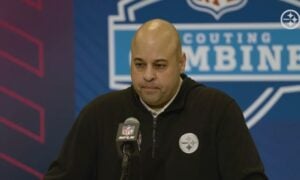Since everybody keeps talking about it, it’s going to keep popping up here, so bear with me, because this is yet another ‘Is drafting a running back in the first round a mistake?’ piece, after Pittsburgh Steelers general manager Kevin Colbert was asked on SiriusXM yesterday if the team ever entertained the thought of avoiding the position in that way.
“A great player is a great player, regardless of the position,” he told Pat Kirwan. “We can look at all that data and so on and so forth. I’ve said it before, I’ve been around two Hall of Famer runners and they were both first-round picks in Jerome Bettis and Barry Sanders, and I know they helped us win a lot of games.”
Admittedly, those are awfully dated references. Bettis is the comparative young gun here, and he last played a down in 2005. The NFL has changed substantially since then. The league averaged 449 rushing attempts per team that year versus 514 pass attempts. The averages are now closer to 415 versus 560 or thereabouts, in any given year.
The point being, a running back was arguably more valuable 15-20 years ago than it is today. Certainly, pass-protecting offensive linemen and wide receivers (in volume) were less valuable, as three-receivers sets are far more prolific today. But that doesn’t stop the Steelers’ thinking.
“We don’t buy into that at all,” he said of the analytics theory that always advises against drafting a running back in the first round. “I guess there’s arguments for it, but again, we’re gonna look at the player, regardless of the position. If that player can help us win games and he’s available to us, it’s our job to take him.”
I think it’s a sound general principle, but would strongly disagree with adhering to it religiously. The reality is that the majority of draft picks, including first-rounders, ultimately do not develop into becoming the players teams expected them to become. If you’re more confident that the running back is going to be who you think he is than a tackle, there’s a case to be made there.
And there is certainly a case to be made that Najee Harris was one of the cleanest and safest prospects in this entire draft class, in terms of getting the player as advertised. He is the most complete back in the group, with really the only thing he lacks being elite speed, even if he is no slouch.
The Steelers continued to address the running game over the next four rounds by drafting a run-blocking tight end in Pat Freiermuth and two offensive linemen, those being Kendrick Green along the interior and Dan Moore Jr. at tackle. The future view of this draft class will swing dramatically based on how those two linemen develop, I would wager, more than on Harris.








